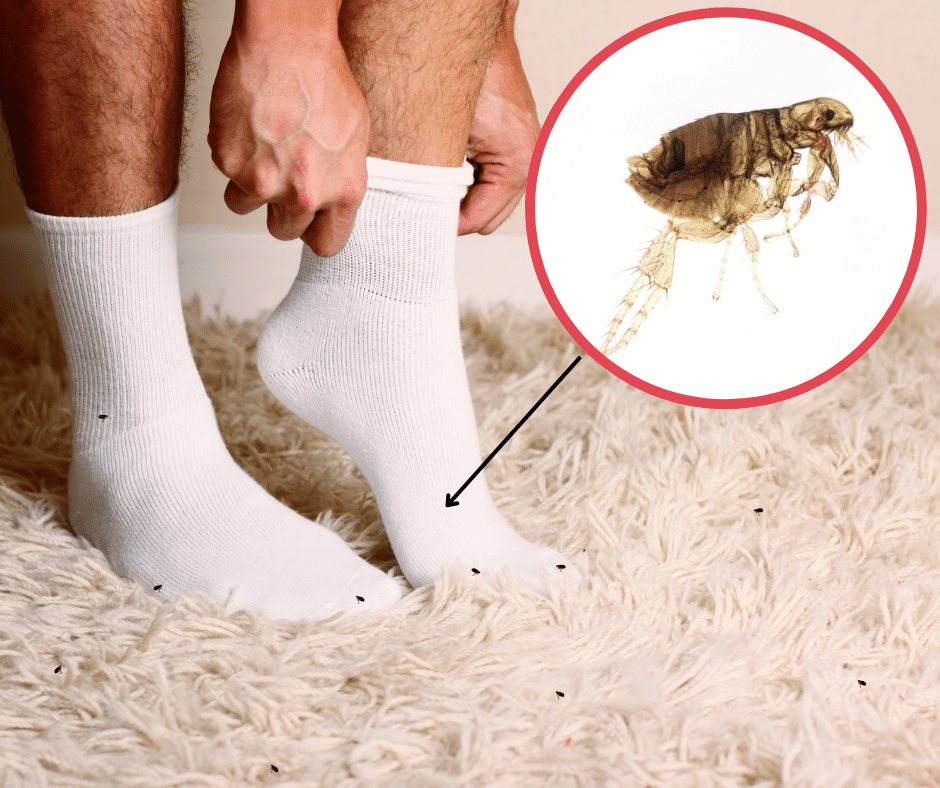
Many people don’t realize that fleas can infest homes—not just the bodies of animals and pets. Their small size and ability to move quickly make them difficult to detect. Once fleas have established themselves in your home, they can be extremely challenging to eliminate. Recognizing the signs of a flea infestation early is crucial for effective control and prevention.
Signs of a Flea Infestation
1. Unusually Itchy Pets
If your cat or dog is scratching more than usual, biting or grooming themselves excessively, or shaking their heads frequently, fleas might be the cause. Here’s what to look for:
- Physical Inspection: Examine your pet’s body, focusing on the belly, tail, groin, and neck areas. Fleas appear as small, fast-moving, dark-colored insects about 1/8 of an inch long.
- Skin Irritation: Look for red bumps, patches of hair loss, or rashes on your pet’s skin.
- Flea Dirt: This is tiny, dark-colored specks of digested blood (flea excrement) that turn red when wet. You might find flea dirt on your pet’s skin or in their bedding.
2. Itchy Bites on Your Lower Body
Flea bites on humans commonly occur on the feet, ankles, and legs because these areas are easily accessible as you walk through your home. The bites appear as small, itchy bumps that may be reddish on lighter skin and darker on deeper skin tones. Unlike bedbugs, which often bite exposed areas like arms and neck, fleas tend to focus on the lower body.
3. Visible Fleas and Flea Activity
While flea eggs, larvae, and pupae are tiny and hard to spot, you might notice signs such as:
- Tiny White Particles: Flea eggs may look like grains of salt or sand on your pet’s bedding.
- Larvae: Small, white, worm-like creatures found on pet bedding, carpets, or furniture.
- Adult Fleas: To detect adult fleas, perform the “white sock test.” Wear white socks that reach your calves and walk through areas where your pet spends time. Fleas are attracted to body heat and movement and will jump onto the socks, making them easily visible against the white background.
How to Address a Flea Infestation
Fleas reproduce rapidly, and their eggs are resistant to many common pesticides. Prompt and thorough action is essential to eliminate an infestation.
1. Treat Your Pets
- Consult a Veterinarian: Use vet-recommended flea treatments, which may include topical applications, oral medications, or flea collars.
- Regular Grooming: Bathe your pet with flea shampoo and use a flea comb to remove fleas and eggs.
2. Clean Your Home Thoroughly
- Vacuum Frequently: Vacuum carpets, rugs, upholstery, mattresses, and cracks in floors daily. This helps remove adult fleas, larvae, and eggs. Dispose of the vacuum bag or empty the canister outside immediately after each use.
- Wash Bedding: Wash all pet bedding, blankets, and human bedding in hot water and dry on high heat to kill fleas at all life stages. Do this at least once a week.
- Steam Cleaning: Consider steam cleaning carpets and upholstery to eliminate fleas and their eggs.
3. Use Environmental Controls
- Insect Growth Regulators (IGRs): Apply IGRs to carpets and furniture to prevent flea larvae from developing into adults.
- Diatomaceous Earth: Sprinkle food-grade diatomaceous earth on carpets and pet areas. It dehydrates fleas but should be used carefully and kept away from pets’ eyes and noses.
4. Maintain Your Yard
Outdoor Treatment: Treat your yard if your pet spends time outside. Keep grass trimmed and remove debris where fleas and wildlife may harbor.
5. Monitor Progress
- Regular Checks: Continue inspecting your pets and home for signs of fleas. Complete eradication may take several weeks due to the flea life cycle.
- Repeat Treatments: Follow up with treatments as recommended to ensure all fleas are eliminated.
6. Seek Professional Help if Necessary
If home remedies are not effective or the infestation is severe, consider hiring a licensed pest control professional. They can provide targeted treatments that are safe for your family and pets.
Prevention Tips
- Regular Vet Visits: Keep up with your pet’s preventative flea treatments year-round.
- Limit Wildlife Access: Prevent wild animals that may carry fleas from entering your yard.
- Clean Regularly: Maintain a regular cleaning schedule to reduce the likelihood of an infestation.
By recognizing the signs of a flea infestation early and taking comprehensive action, you can protect your pets and family from the discomfort and health risks associated with fleas.
